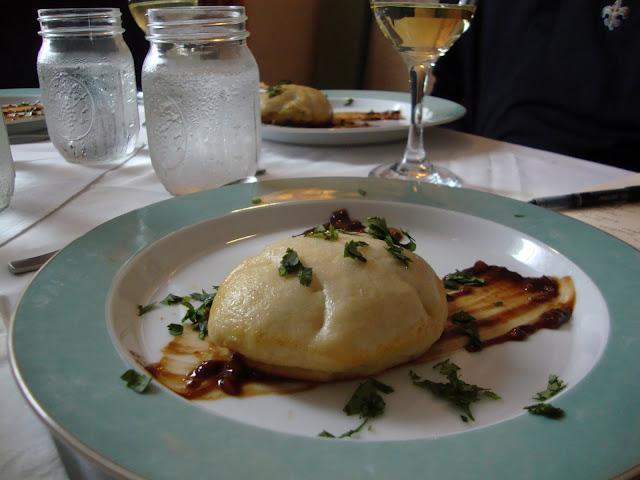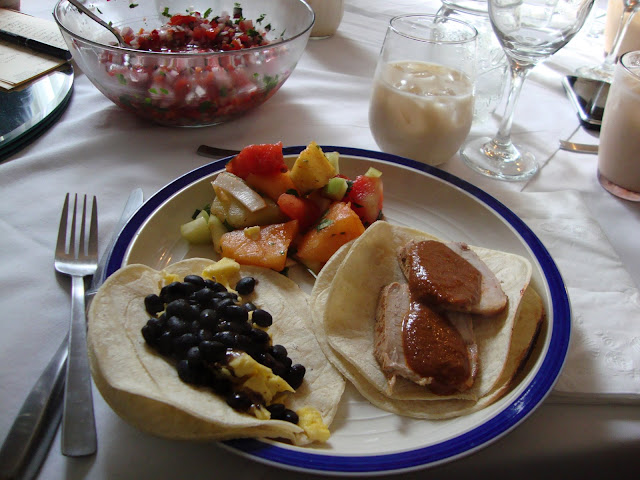As usual I had a specific wine in mind when I planned the menu. Knowing how much I love the wines and foods of the Bastianich family, our friend Monica from Neat Wines brought 2006 Bastianich Calabrone a few weeks ago. New to their portfolio, the nose alone told me I had to have it. Besides the fact that it is only released in excellent vintages, and that it is a an unusual blend of 40% Merlot, 45% Refosco, 10% Cabernet Franc, 5% Pignolo, the other thing that makes "Super Friulian" so special is the vinification process. To punch up the flavors and soften the tannins of the Refosco and Cabernet Franc they take 30% of the best clusters of the grapes and hang them in a ventilated hilltop attic for a four to eight week drying period. This appassimento process, similar to Amarone, as well as the aging for 2 years in oak and another in bottle before release, results in a truly special wine (so special it was served to the Pope during his visit to New York in 2008!). Deep red fruits, velvety texture, powerful, elegant, with some delicious spices, cocoa and espresso, notes this needs some robust food!
Enough about the wine, what about the food?? Since I've been on such pasta kick lately, I decided to make some fresh pappardelle and do a Porcini and Pancetta Cream Sauce. And what better to accompany the pasta than a big steak served Tuscan style and a nice salad with heirloom lettuces and mache.
So, the pasta; to make the pappardelle I used my usual recipe for Pasta all'Uovo. Once you roll out the sheets, cut them in half crosswise to make 10 strips about a foot long and 5" wide. Lay them out in trays, in layers, lightly floured and covered with towels. Take one of the strips, and lay it out on a floured board; dust the top with flour as well. Starting at one end, fold the sheet over on itself in thirds or quarters, creating a small rectangle with 3 or 4 layers of pasta.
With a sharp knife, cut cleanly through the folded dough crosswise in 1-1/2-inch wide strips. Separate and unfold the strips, shaking them into long noodles. Sprinkle liberally with flour so they don't stick together. Fold, cut, and unfurl all the rolled pasta sheets this way, and spread them out on a floured tray. Leave them uncovered, to air-dry at room temperature until ready to cook.
The Sauce:
Ingredients
* 3/4 cup dried porcini mushrooms
* 1-1/2 cups hot water
* 1 pound pappardelle
* 2 tablespoon olive oil
* 2 tablespoons unsalted butter
* 1-1/2 ounces pancetta
* 1/3 cup minced shallots
* 3 teaspoons minced garlic
* 1-1/2 cups heavy cream
* dash of truffle oil
* 3/4 teaspoon chopped fresh thyme
* salt
* freshly ground black pepper
* 3 tablespoons chopped fresh parsley
* 1/2 cup grated Parmigiano-Reggiano cheese
Instructions
Place the dried mushrooms in a medium bowl, cover with the hot water, and let sit until reconstituted and soft, about 15 minutes. Drain the mushrooms and their liquid through a fine mesh strainer into a clean bowl, squeezing the mushrooms to extract as much liquid as possible. Reserve the liquid and roughly chop the mushrooms. Set aside.
Bring a large pot of salted water to a boil. Have it ready to go, because the fresh pasta cooks very quickly.
Meanwhile, a little of the oil in a large skillet and brown the pancetta. Remove and drain on a paper towel. Add the rest of the oil and melt the butter in the skillet over medium heat. Add the shallots and cook, stirring, until soft and fragrant, about 2 minutes. Add the garlic and cook, stirring, until fragrant, 30 seconds. Add the chopped mushrooms, and cook, stirring, for 2 minutes. Add the reserved mushroom liquid, bring to a boil, and cook, stirring occasionally, until the liquid is nearly all evaporated, 3 to 4 minutes. Add the cream, thyme, salt, pancetta, dash of truffle oil and pepper and return to a simmer. Cook, stirring occasionally, until the cream is reduced and thick, 4 to 5 minutes. Add a few tablespoons of the cheese and the parsley and stir to incorporate.
Add the pappardelle to the boiling water and cook until al dente, 2 to 4 minutes for fresh pasta. Drain the pasta and add to the pan with the sauce, tossing well to coat. Add 2 more tablespoons of the cheese, toss, and remove from the heat. Serve immediately and use the rest of the cheese for garnish on the plates.
And the steak? My version of bistecca fiorentina, the first time we made this was with freshly cut Chianina beef steaks over an open fire in a villa in Tuscany with 8 of our close friends. Although we'll never be able to recreate that special experience, it is still one of my favorite preparations and it always take me back to that magical night.
Grill some fresh t-bones rubbed in olive oil, salt and pepper, they should be pretty rare. While the steaks are cooking, fry a big handful of fresh sage and some rosemary in a good amount of olive oil until the sage leaves are crispy.
When the steaks are done, put them on a cutting board and thinly (1/4") slice the meat of the bone. Put the meat on a serving dish and pour the hot olive oil and herb mixture over to finish cooking and seal in the juicy flavor. Salt and pepper to taste.
Buon Appetito!

















